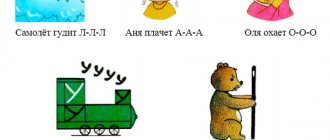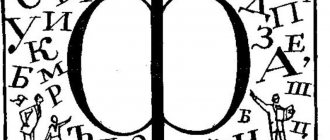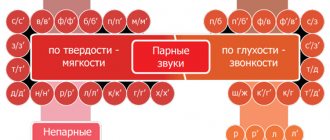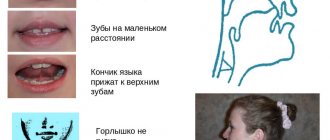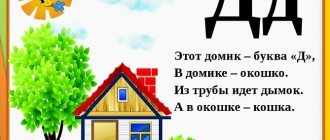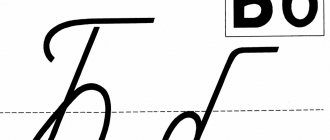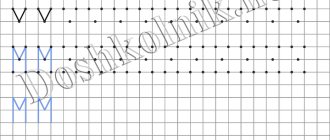Differentiation from consonant sounds
Preschoolers have problems distinguishing paired sounds. They often change “Z” to “S”. To solve this problem, the teacher offers differentiation games.
Work on differentiation of sounds is carried out in the following directions:
- development of auditory differentiation;
- consolidation of pronunciation differentiation;
- formation of phonemic analysis and synthesis.
First, the speech therapist asks you to feel the difference in pronunciation using your hand, which is located on your neck.
It is important for children to remember that with “Z” the throat vibrates.
Then children place an open palm in front of their mouth and feel the difference in the air stream that comes out when pronouncing similar sounds.
At the next stage, work is carried out with speech material with mixed sounds. Exercises are carried out to divide words into groups with different letters, gymnastic games with clapping and other movements.
Sound automation
Exercises for automating the sound Z: isolated, in syllables, words and sentences.
Automation of the sound Z begins with the easiest tasks for the baby.
Sing the mosquito song.
Say sound 3 for a long time on one exhalation: z-z-z...
Repeat straight syllables:
za-zo-zu-zy.
Repeat the reverse syllables:
az-oz-uz-yz-iz-ez-ez-yuz-yaz.
Repeat the syllables where the sound 3 is between the vowels:
aza-azo-azu-azy uza-uzo-uzu-uzy oza-ozo-ozu-ozy yza-yzo-yzu-yzy
Repeat straight syllables with consonant clusters:
zna-zno-znu-zny zva-zvo-sound-zvy zma-zmo-zmu-zmy zda-zdo-zdu-zdy
Repeat the words where the sound 3 is at the beginning of the word:
For: west, bunny, castle, factory, fun, care, law, riddle, sunset, task, activity, stop by, groan, want, smell, corral, race, bully, forget, cufflink, but, run in, gore, cherished, curl, howl, make a wish, drive in, prepare, prepare, get ready, conceive, blow out, stutter, come in, bury, throw in, throw in, boil, nook, start, undertaking, tighten up. Zo: Zoya, umbrella, umbrella. Zu: teeth, tooth, tooth, tooth, catfish. PS: unsteady. Confluence of consonants: know, sign, call, call, sound, banner, called, ringing, call, ringing, familiar, connoisseur, heat, introduce.
Repeat words where the sound 3 is in the middle of the word.
For: Vase, base, goat, fidget, back, mosaic, mimosa, pheasant, forget-me-nots, punish, smear, show, indicate, jellyfish, Cossack, indication. Az: alphabet, name, name. Zo: bison, cart. Oz: air. Zu: I’m bringing fuel oil downstairs. PS: name, language, carts, basins, goats, vases, musician, music. From: hut, excess, bend, edition, crumple, wrong side. Cluster of consonants: wave, sigh.
Repeat words with two sounds 3.
To tie, to ring, arrogant, to call, to cover up, a splinter, to drive around.
Repeat the phrases.
new umbrella funny bunny new basins familiar music familiar musician
hot day ringing bell dinner party funny kitten
clockwork goat Zoya's idea dark nook dental floss
Repeat the sentences.
Three words. Zoya has a goat. Zoya has an umbrella. Zoya buys the alphabet. Zoya asks riddles. Zoya's dad is a musician. Four words. Zoya knows a lot of mysteries. Zina is late for class. Zara shows the alphabet to the bunny. The zone bunny's name is Zaznayka. Mom gives Zoya a new umbrella. Five words. Pheasants drink water from a basin. Aunt Zoya rings the bell. Zoya is grazing a goat under an umbrella. They carry a lot of locks on the cart. Aunt Zoe doesn't have an umbrella. Zoya is a bully and arrogant bunny. In vases there are mimosas and forget-me-nots. Six words. The castle has a lot of forget-me-nots and mimosas. Mom asks Zoya a riddle about a bunny.
(According to E. N. Spivak)
Preparatory exercises
Speech therapy correction work begins with the preparatory stage, which includes:
- preparing children for classes;
- exercises to train the articulatory apparatus;
- study of speech organs;
- familiarization with self-massage techniques;
- exercises to develop the muscles of the neck and shoulders;
- development of fine motor skills.
The lesson begins by inviting the child to play; you can tell him fairy tales about the Tongue. If you get your child interested, he will perform the exercises more actively, which means he will achieve a positive result faster.
Preparatory complex:
Children are more willing to do exercises with edible straws.
- Self-massage. The fingertips stroke the facial muscles in the direction of:
- from the middle of the forehead to the temples;
- around eyes;
- from the bridge of the nose to the ears;
- along the back of the nose up and back.
- Vibration massage. Tapping the wings of the nose while pronouncing the sound “M”.
- Studying parts of the speech apparatus in front of a mirror. Together with the child, name the speech organs and consider their location.
- Games for stretching and relaxing the muscles of the shoulder girdle: “Stretch”, “Cat”.
- Lacing games according to the Montessori system for training fingers and developing fine motor skills.
Setting the sound
Speech therapy work on sound production is carried out in 5 areas:
- By imitation. To do this, the child must have developed phonemic hearing.
- Using a mechanical method. If the child cannot independently shape the tongue or make vibrating movements, then the speech therapist helps with special tools (spatula, spatula). To minimize the use of instruments, much attention is paid to articulatory gymnastics in classes.
- Based on formed sounds. “Z” is well placed on the basis of the related “S”. If “C” is also not sufficiently worked out, then they put “C” from “T”. Gradually, the child reproduces “Z” by adding his voice.
- Staging from articulation exercises. To pronounce sibilants, the tongue performs complex movements, using the tip of the tongue, its back and lateral edges. The lips and jaw should also be active when speaking. To practice precise movements of the speech organs, articulatory gymnastics are performed.
- Mixed method. An individual correction plan is drawn up, which includes the listed methods.
By imitation
Setting phonemes by imitation requires the teacher to have competent speech and correct sound pronunciation, because children copy the articulation of adults. To stage “Z,” you can invite preschoolers to play the game “Mosquitoes.”
The teacher asks the children to remember how mosquitoes buzz and ring in the summer. Children are divided into 2 categories: “mosquitoes” and “tourists”. Hoops are placed on the floor. The task of the “mosquitoes”: to catch the “tourists”, the task of the “tourists”: to run from the “mosquitoes” into a hoop. Children who pretend to be mosquitoes utter a loud, drawn-out “ZZZZZZZ.” After a few minutes, the participants switch roles.
After the game, the teacher pays attention to the sound of “Z”, sonority and volume. It is necessary to monitor the completion of the task for each child and check the correct position of the speech organs.
Mechanical method
If a child cannot independently put his lips and jaw in the desired position, a specialist will help him with this. He:
- asks the child to smile,
- and at the same time holds his lower and upper lips with a clean finger or spoon,
- in this position, the child pronounces a long sound “Z”,
- As soon as a clear sound is obtained, the finger is removed.
The exercise is repeated until the sound is heard. It is important to teach the child to involuntarily lower and raise his lips.
Staging from reference sounds
Specialists begin working with whistling people with the sound “S”, from which they later add “Z” and “C”.
The difference between “Z” and “S” is that when pronouncing a voiced “Z”, the vocal cords close and vibrate, the pressure of exhaled air becomes weaker, and the gap between the tongue and the alveoli is narrower. The air stream is less intense than when pronouncing “C”.
The speech therapist asks the child to say “SSS” and then add voices to the sound. The presence of a voice can be controlled by hearing, as well as by tactile sensations by placing a hand on the neck.
Staging from articulation exercises
Exercises for articulating the sound “Z”:
- "Gorochka". The teacher and the child remember what a mountain looks like and depict its shape with their hands. Afterwards, the child is asked to create a mound with his tongue, lifting its middle.
- "Breeze". The child stretches out his lips with a tube and blows, after which the teacher lifts his upper lip and asks him to blow again.
- "Lock". Teeth closed, lips parted. The speech therapist explains that the tongue is behind the fence and cannot be released. The child presses his tongue against his teeth several times.
- "Climber". The tip of the tongue rests on the lower incisors, the back of the tongue arches. The child is explained that the lower jaw is part of the rock on which the tongue needs to rest. The movement of the tongue is monitored using a mirror and the number of seconds it is possible to hold in this position is noted.
- "Stream." The mouth is slightly open, the teeth are not completely closed, so as to form a gap. The child is invited to play with the stream: release a stream of air through the resulting crack.
- "Coil". The tip of the tongue is pressed from the inside to the lower incisors. The middle part of the tongue bends strongly, forming a hollow in the center. The tongue rolls out of the mouth and hides back. An important condition: do not tear the tip of your tongue from your teeth.
- "Naughty tongue." The mouth is open, the tongue is relaxed, lying in the middle of the lower lip. The child slaps his tongue with his lips without touching it with his teeth.
Automation in spontaneous speech
Consolidating the sound “Z” in spontaneous speech includes adult control over the child’s pronunciation.
It is important to monitor correctness and immediately correct defects so that the child does not develop stereotypes.
You can return to each stage of sound production if necessary, and play games for reinforcement and automation.
Adult speech is the main tool for fixing sounds in a child’s phonemic structure. By surrounding children with literate speech, adults create an atmosphere for the correct development of their sound pronunciation.
Types of incorrect articulation
Violations in the pronunciation of “Z” can be divided into 2 groups:
- expressed in distorted pronunciation of whistling sounds (sigmatism);
- expressed in replacement with other sounds (parasigmatisms).
Types of sigmatism:
- Interdental. The tip of the tongue is located between the teeth. Speech acquires a “lisp.”
- Side. The lateral edge of the tongue is pressed to the right or left to the molars. The tongue rolls to one side.
- Nasal. When speaking, air enters the nasal cavity. Nasal sigmatism occurs in children with cleft palate or palate paralysis.
Types of parasigmatism:
- Prizubny. When pronouncing the sound “Z”, the tongue rests on the closed teeth. Because of this, “Z” is replaced by “D”.
- Hissing. During pronunciation, the lips are strongly rounded and no groove is formed on the tongue. "Z" changes to a soft "F".
- Emollient. The mouth does not open enough, the teeth do not come apart from each other. The result is a sound that is softer than required.
- Replacements due to deafness. The lips are drawn out into a long tube, the tongue does not rest on the teeth, and there is no sonorous sound.
If defects in sound pronunciation are not corrected, then during school years the child will develop illiterate oral and written speech and will have problems with reading and understanding what is read.
In addition, problems with sound pronunciation can arise as a result of damage to the speech parts of the brain.
If a child has a correctly formed articulatory apparatus, but the sound is still not produced, it is worth seeking advice from a neuropsychologist. He will conduct a diagnosis and draw up a correction plan.
Articulation of sound Z
The lips are not tense, stretched, as with a slight smile, then take the position of the following vowel.
The teeth are brought closer together by 1-1.5 mm, the upper and lower incisors are exposed.
Tongue – the tip of the tongue is wide, located behind the lower teeth, at the lower alveoli; the front and middle part of the back of the tongue rises slightly higher to the upper gums than when pronouncing the sound C, but the tension of the tongue is somewhat weaker and in the form of a longitudinal groove between the back of the tongue and the alveoli is narrower than with voiceless C and C'; the back of the back of the tongue is raised, the lateral edges of the tongue fit tightly to the inside of the upper and partly lower lateral teeth, closing the passage of the air stream on the sides.
The soft palate is raised, blocking the passage of the air stream into the nasal cavity.
The vocal cords are closed and vibrate.
The air stream is narrow, cold, but weaker and less tense than when pronouncing the sound C.
